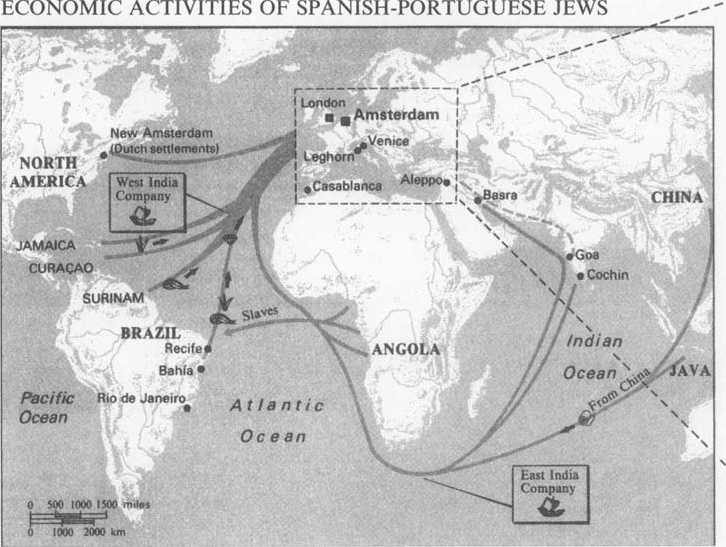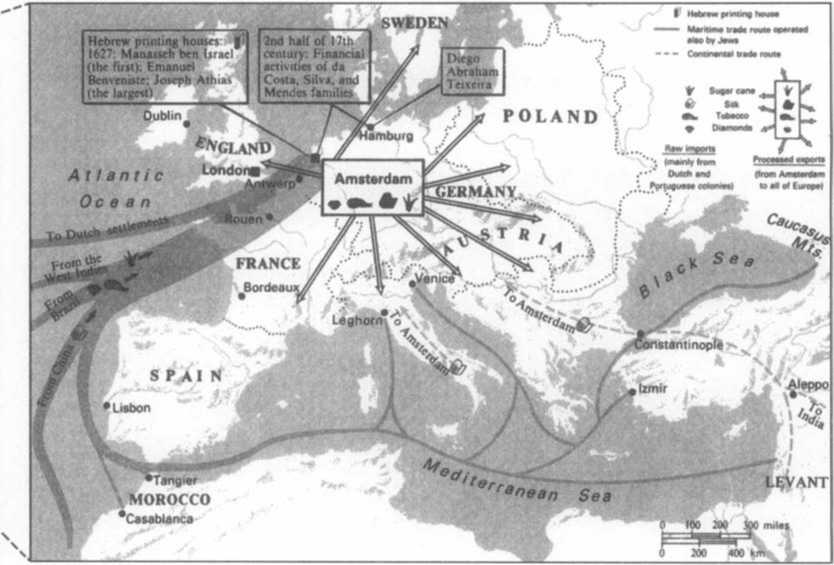The Spanish-Portuguese Jews (Sephardim) were among the harbingers of the modern era in Jewish history. Some were descendants of the Jews expelled from Spain (1492) and Portugal (1496-1497). Most, however, were “New Christians”—Jews who had been forced to convert in those countries, continued to observe Judaism secretly, and returned to open Jewish life when circumstances allowed. They then created new Jewish communities, some of which became very important.
The New Christians who left Spain and Portugal during the sixteenth century (frequently because of the Inquisition) settled mainly in northern Italy, the
Netherlands, and southern France. During the next century, many moved northward, still to the Netherlands, and from there to northern Germany (Hamburg, Altona), England, and even North and South America. Some settled (without establishing communities) in Central and Eastern Europe.
The great center of Sephardic Jewry was Amsterdam. In the seventeenth century, Amsterdam was a city of intense economic and cultural life, with a relatively tolerant religious atmosphere. The Jewish community in Amsterdam, which began to organize itself at the end of the sixteenth century, was very small (in modern terms)—between 2,500 and 5.000 Jews, or 1 to 2 percent of the city’s population. Other Spanish-Portuguese communities of the seventeenth century were not larger: 500 Jews lived in London; 3,000 lived in Leghorn, one of the oldest communities. Important communities existed in Venice, Bordeaux (recognized by the authorities only in the 1720s), and Hamburg. The Amsterdam community was the economic and cultural center for the whole Sephardic dispersion, and its spiritual influence was felt far beyond Jewish circles. Its cultural creativity, influenced by the fecund amalgamation of Jewish and non-Jewish spiritual elements, was highly original and expressed itself in important religious and philosophical works. One important center of Amsterdam Jewry’s religious activity was the Etz Haim Yeshiva. The influence of the European Spanish-Portuguese Jews declined in the late eighteenth century, their gradual assimilation into the general society.


Ashkenazic Jews began to settle in Amsterdam at the end of the seventeenth century, their number rising to about
10.000 in the eighteenth century. The relations between them and the older, patrician strata of Sephardim were mostly strained.
“New Christians’’ traveled to the Americas as early as the sixteenth century. In 1630, Spanish-Portuguese Jews from Amsterdam arrived in the Portuguese colony of Recife, in northeastern Brazil, then under Dutch domination.
They established two communities, the first in the New World. With the expulsion of the Dutch from Recife in 1654, the Jews also left. Some of them went northward, to Dutch or English settlements; Surinam, Curacao, Jamaica, Barbados, and New Amsterdam, which in 1664 came under English domination and changed its name to New York. Other Jews, mostly Spanish-Portuguese, migrated from England and Holland in the seventeenth and eighteenth centuries and established about a dozen communities in North America. Ashkenazic Jews started arriving in the eighteenth century.

The legal situation of the Jews in the English and Dutch colonies was much better than in Europe. European rulers wished to attract settlers to the New World, and various laws in the seventeenth and eighteenth centuries (the law regarding Surinam in 1665, and the Plantation Act of 1740) guaranteed the Jews broad social and civil rights. With
American independence in 1776, the Jews there became full and equal citizens of the republic. Their social and economic situation was satisfactory, too. The number of Jews in the Americas remained small: no more than about 3,000 at the end of the eighteenth century, two-thirds of them in North America, which also became the main destination of Jewish immigration: in about 1820, some 15,000 Jews lived in North America.
ECONOMIC ACTIVITIES 17th and 18th centuries
Spanish-Portuguese Jews were influential in international commerce in the seventeenth and eighteenth centuries. Their experience, financial means, and international family connections enabled them to build a network of economic relations that spanned the entire known world. Operating out of Amsterdam, London, Hamburg, Leghorn, and other commercial centers, these Jewish entrepreneurs carried commodities from and to the Mediterranean countries, Africa, the Americas, India, and even China. In many of these places, they were represented by family members or Sephardic acquaintances. Sugar, tobacco, silk, and precious stones were among the main products that the Spanish-Portuguese Jewish merchants imported into Europe. They were also involved in the printing Industry in Europe, producing books with both Latin and Hebrew characters. They participated in two large commercial concerns: the East India Company, active in India and Asia in general; and the West India Company, active in the Western Hemisphere. They also played a role in the development of the modern banking system.

The Sephardic Jews did not act independently, but as part of the economic life of the centers where they lived. They were far from being among the most important merchants in places like London or Amsterdam. In general, they belonged to the more prosperous segment of the population, but many Christian merchants were much richer. Jews were usually forced to take greater business risks, and the competition from the Christian guilds of merchants and craftsmen gradually drove them from dealing in many profitable goods, such as sugar and silk. Only in one field, precious stones, have Jews, mainly of Ashkenazic stock, maintained a leading presence throughout the modern era.
Source: WorldHistory 7-05-2015
 eSefarad Noticias del Mundo Sefaradi
eSefarad Noticias del Mundo Sefaradi

